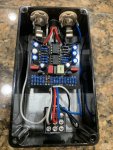dlazzarini
Well-known member
I’ve just recently built the Triangulum build. It’s a working build but something sounds off. When I turn the level up to a decent level or about half way up I get a really bassy heavily saturated sound that starts to cut out and break apart when heavy power chords are hit. Like it’s being overwhelmed. Ive got 9volts on pins 1/8 which are connected at VCC from what I can tell I’ve only got 5.6 volts


Last edited:

